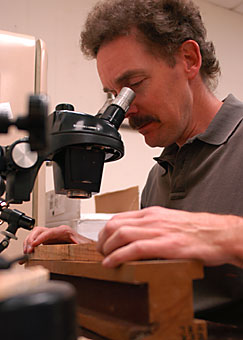 |
|
JACOB KONST/Arizona Daily Wildcat
|
Paul Sheppard, associate professor at the UA Laboratory for Tree-Ring Research, examines tree rings from a Mexican pine that lived near Parícutin, a volcano in central Mexico.
|
|
|
By Jessica Lee
Arizona Daily Wildcat
Thursday, January 22, 2004
Print this
What happens when you put a dendrochronologist, an archeologist and a volcanologist in a room together?
They attempt to re-date a Northern Arizona volcanic eruption.
Paul Sheppard, an associate professor and researcher at the UA Laboratory of Tree-Ring Research, along with two other scientists have preliminary results that show a volcano thought to have erupted in 1064 A.D. might have erupted 30 years earlier.
The crater, a cinder cone located east of Flagstaff, dramatically affected the lives of the prehistoric people who were living nearby at the time of its eruption. Archeologists rely on dating such geologic features to understand past American Indian cultures.
Researchers in the 1950s were the first ones to date the volcano. They said that the eruption began in 1064, and lasted for approximately 200 years.
"The date 1064 is considered gospel," said Mark Elson, an archeologist with Desert Archeology, Inc. Elson's interest in re-evaluating the date of the eruption took hold during excavations near to Sunset Crater Desert Archeology performed for the Arizona Department of Transportation in the last five years.
"Knowing the precise date is very significant in archaeology and Flagstaff prehistory because it could dramatically change the reconstruction of the area," Elson said.
Sheppard was excited to extend his knowledge of tree rings and soils to pin a more precise date on the eruption of Sunset Crater.
The study of tree rings, or dendrochronology, has been used for decades to date events such as volcanic eruptions. In order to date events, scientists try to determine whether trees have narrow rings that indicate a period of stress, such as a drought or an insect infestation.
When Sheppard, Elson, and Michael Ort, a volcanologist at Northern Arizona University, decided to date Sunset Crater, they needed to find trees that survived an eruption from a similar volcano.
The eruption of Parícutin in the Mexican state Michoacán happened only 50 years ago, and was the match they were looking for.
Last January, the research team traveled to Parícutin to observe tree rings from trees that survived the ash fallout from the eruption. The eruption lasted from 1943-1952, so the team needed to find trees that dated back to at least the 1930s.
Ort recalls how they got a tree-ring sample from the stump of a tree cut down in 1997.
"We had to drive up a rough road through the mountains to a village. This village looked like it would have 200 years ago; there were no cars. Eventually, we found some young boys to use their chain saw to cut down stumps. Once we convinced their moms we weren't going to kidnap them, we got them to cut a sample for us," Ort said.
Although the researchers found signs of stress in the tree from the period of the
volcanic eruption, Sheppard wanted to know more about how the eruption affected the health of the trees.
"What interested us more was if there were any chemical changes," Sheppard said.
The team hypothesized that nitrogen levels, the most important nutrient to plants, in the tree may have increased because of ash from the eruption.
But laboratory analysis found there were no overwhelming changes in nitrogen patterns. Further analysis did find an increase in phosphorus, which comes from ash and is utilized by trees.
It was a landmark discovery because the team found a chemical change that correlated to the same period as the eruption, Sheppard said.
Jeffrey Dean, professor in the tree-ring laboratory, provided a tree-ring sample from an archeological site located near Sunset Crater, so researchers could compare the two samples.
By studying both the stress on the tree rings and the increase in phosphorus, Sheppard believes his team may be able to more accurately date the eruption.
"Having an exact date for the eruption is pretty key to interpreting the reaction of local community at the time. This could really change the archeological models of the community settlements before and after the eruption," said Sue Fisher, exhibit specialist for the National Park Service for parks in the Flagstaff area.
The preliminary results of Sheppard and his team's data will be incorporated into the new exhibit underway at the Sunset Crater Volcano National Park.
The research, which began a year ago, received a small grant from the National Park Service. The team submitted a grant proposal to the National Science Foundation Dec. 1, 2002, and hopes that the project will receive more funding.
The team hopes to return to Parícutin in March.
"Paul's work will help pinpoint the date of the Sunset Crater eruption. This could be quite big if he can perfect the method that analyzes the chemical signatures in trees as the result of an eruption," Elson said.
